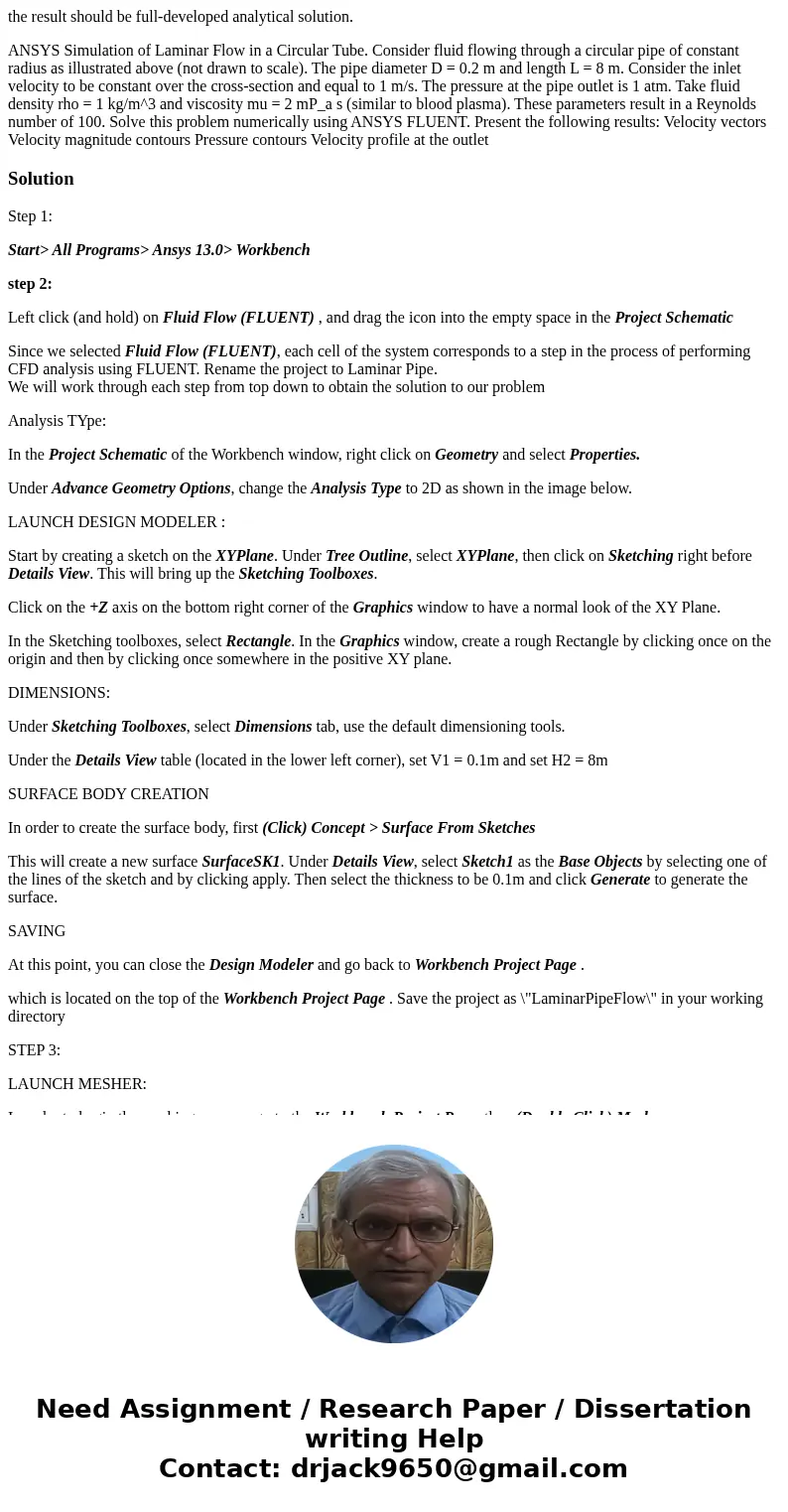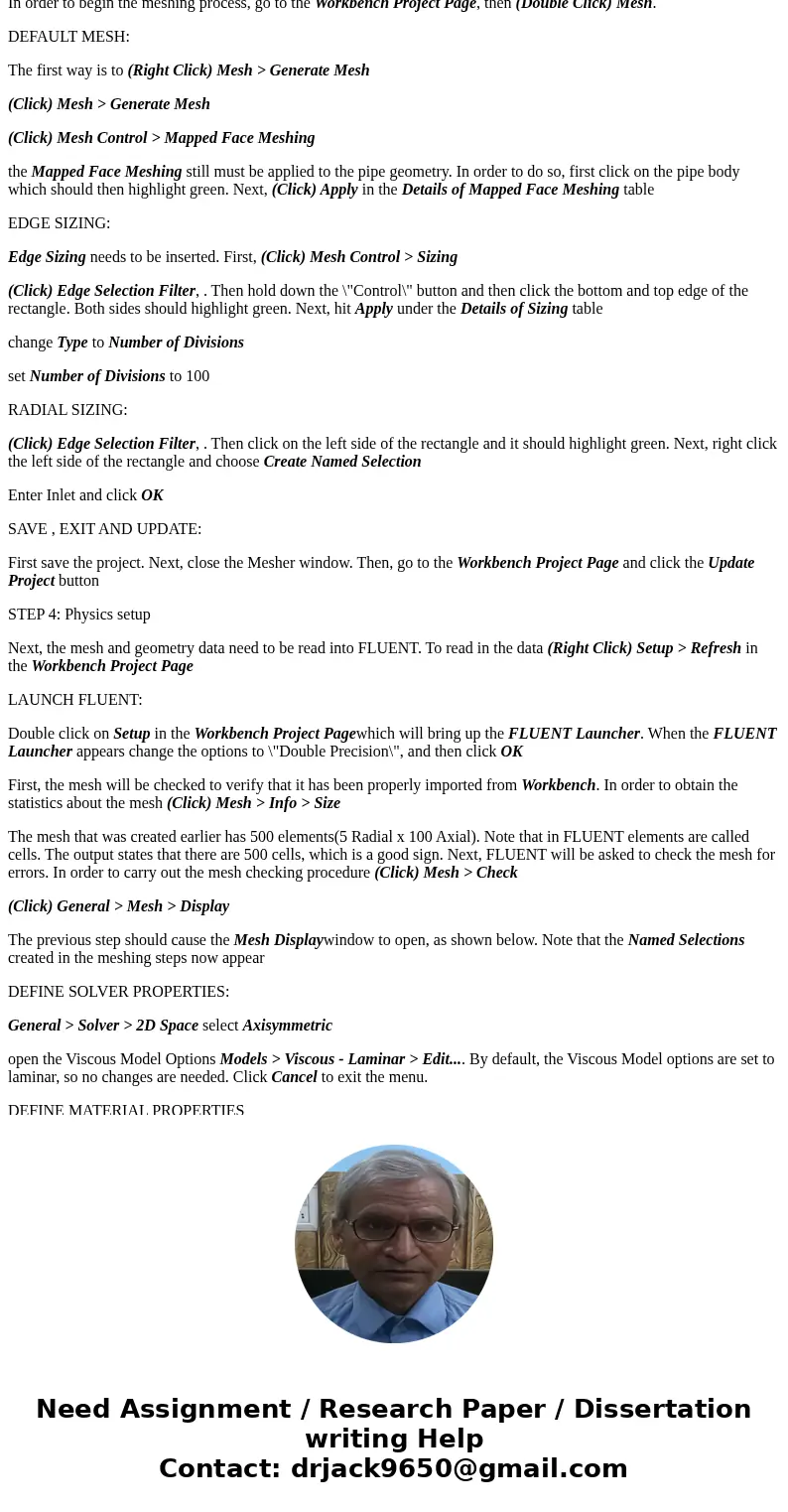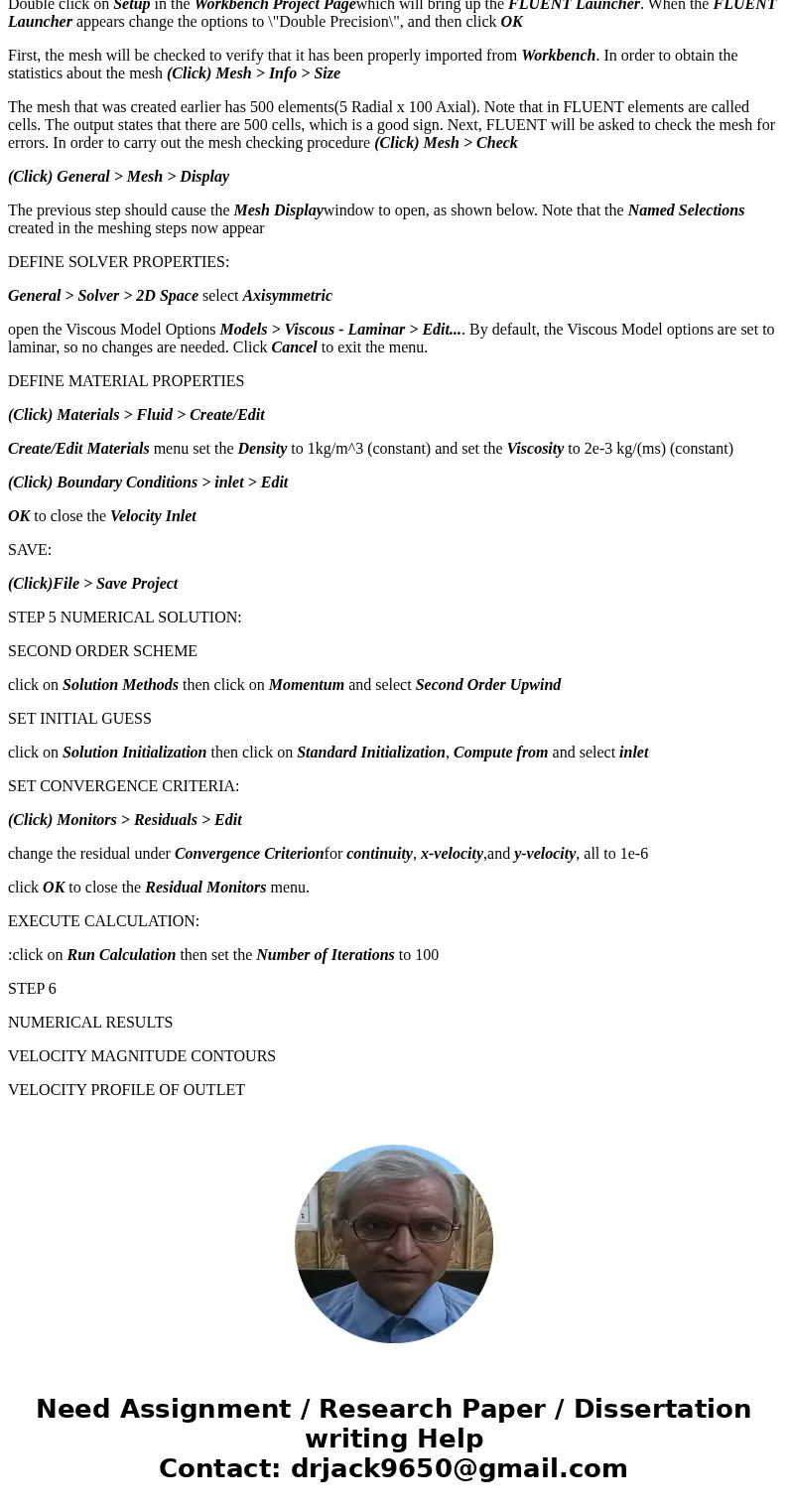the result should be fulldeveloped analytical solution ANSYS
the result should be full-developed analytical solution.
ANSYS Simulation of Laminar Flow in a Circular Tube. Consider fluid flowing through a circular pipe of constant radius as illustrated above (not drawn to scale). The pipe diameter D = 0.2 m and length L = 8 m. Consider the inlet velocity to be constant over the cross-section and equal to 1 m/s. The pressure at the pipe outlet is 1 atm. Take fluid density rho = 1 kg/m^3 and viscosity mu = 2 mP_a s (similar to blood plasma). These parameters result in a Reynolds number of 100. Solve this problem numerically using ANSYS FLUENT. Present the following results: Velocity vectors Velocity magnitude contours Pressure contours Velocity profile at the outletSolution
Step 1:
Start> All Programs> Ansys 13.0> Workbench
step 2:
Left click (and hold) on Fluid Flow (FLUENT) , and drag the icon into the empty space in the Project Schematic
Since we selected Fluid Flow (FLUENT), each cell of the system corresponds to a step in the process of performing CFD analysis using FLUENT. Rename the project to Laminar Pipe.
We will work through each step from top down to obtain the solution to our problem
Analysis TYpe:
In the Project Schematic of the Workbench window, right click on Geometry and select Properties.
Under Advance Geometry Options, change the Analysis Type to 2D as shown in the image below.
LAUNCH DESIGN MODELER :
Start by creating a sketch on the XYPlane. Under Tree Outline, select XYPlane, then click on Sketching right before Details View. This will bring up the Sketching Toolboxes.
Click on the +Z axis on the bottom right corner of the Graphics window to have a normal look of the XY Plane.
In the Sketching toolboxes, select Rectangle. In the Graphics window, create a rough Rectangle by clicking once on the origin and then by clicking once somewhere in the positive XY plane.
DIMENSIONS:
Under Sketching Toolboxes, select Dimensions tab, use the default dimensioning tools.
Under the Details View table (located in the lower left corner), set V1 = 0.1m and set H2 = 8m
SURFACE BODY CREATION
In order to create the surface body, first (Click) Concept > Surface From Sketches
This will create a new surface SurfaceSK1. Under Details View, select Sketch1 as the Base Objects by selecting one of the lines of the sketch and by clicking apply. Then select the thickness to be 0.1m and click Generate to generate the surface.
SAVING
At this point, you can close the Design Modeler and go back to Workbench Project Page .
which is located on the top of the Workbench Project Page . Save the project as \"LaminarPipeFlow\" in your working directory
STEP 3:
LAUNCH MESHER:
In order to begin the meshing process, go to the Workbench Project Page, then (Double Click) Mesh.
DEFAULT MESH:
The first way is to (Right Click) Mesh > Generate Mesh
(Click) Mesh > Generate Mesh
(Click) Mesh Control > Mapped Face Meshing
the Mapped Face Meshing still must be applied to the pipe geometry. In order to do so, first click on the pipe body which should then highlight green. Next, (Click) Apply in the Details of Mapped Face Meshing table
EDGE SIZING:
Edge Sizing needs to be inserted. First, (Click) Mesh Control > Sizing
(Click) Edge Selection Filter, . Then hold down the \"Control\" button and then click the bottom and top edge of the rectangle. Both sides should highlight green. Next, hit Apply under the Details of Sizing table
change Type to Number of Divisions
set Number of Divisions to 100
RADIAL SIZING:
(Click) Edge Selection Filter, . Then click on the left side of the rectangle and it should highlight green. Next, right click the left side of the rectangle and choose Create Named Selection
Enter Inlet and click OK
SAVE , EXIT AND UPDATE:
First save the project. Next, close the Mesher window. Then, go to the Workbench Project Page and click the Update Project button
STEP 4: Physics setup
Next, the mesh and geometry data need to be read into FLUENT. To read in the data (Right Click) Setup > Refresh in the Workbench Project Page
LAUNCH FLUENT:
Double click on Setup in the Workbench Project Pagewhich will bring up the FLUENT Launcher. When the FLUENT Launcher appears change the options to \"Double Precision\", and then click OK
First, the mesh will be checked to verify that it has been properly imported from Workbench. In order to obtain the statistics about the mesh (Click) Mesh > Info > Size
The mesh that was created earlier has 500 elements(5 Radial x 100 Axial). Note that in FLUENT elements are called cells. The output states that there are 500 cells, which is a good sign. Next, FLUENT will be asked to check the mesh for errors. In order to carry out the mesh checking procedure (Click) Mesh > Check
(Click) General > Mesh > Display
The previous step should cause the Mesh Displaywindow to open, as shown below. Note that the Named Selections created in the meshing steps now appear
DEFINE SOLVER PROPERTIES:
General > Solver > 2D Space select Axisymmetric
open the Viscous Model Options Models > Viscous - Laminar > Edit.... By default, the Viscous Model options are set to laminar, so no changes are needed. Click Cancel to exit the menu.
DEFINE MATERIAL PROPERTIES
(Click) Materials > Fluid > Create/Edit
Create/Edit Materials menu set the Density to 1kg/m^3 (constant) and set the Viscosity to 2e-3 kg/(ms) (constant)
(Click) Boundary Conditions > inlet > Edit
OK to close the Velocity Inlet
SAVE:
(Click)File > Save Project
STEP 5 NUMERICAL SOLUTION:
SECOND ORDER SCHEME
click on Solution Methods then click on Momentum and select Second Order Upwind
SET INITIAL GUESS
click on Solution Initialization then click on Standard Initialization, Compute from and select inlet
SET CONVERGENCE CRITERIA:
(Click) Monitors > Residuals > Edit
change the residual under Convergence Criterionfor continuity, x-velocity,and y-velocity, all to 1e-6
click OK to close the Residual Monitors menu.
EXECUTE CALCULATION:
:click on Run Calculation then set the Number of Iterations to 100
STEP 6
NUMERICAL RESULTS
VELOCITY MAGNITUDE CONTOURS
VELOCITY PROFILE OF OUTLET



 Homework Sourse
Homework Sourse